Have you ever looked at your dashboard after you start your car and see a ton of lights turning on and off? It’s your car running a system check of all those systems, and it’s entirely normal for them to cycle on and off like that.
Each of those lights means something, and while you can ignore them when they’re working correctly, as soon as one doesn’t shut off, you’re left scrambling to figure out what you need to do. In this article we will explain all the different dashboard warning lights, their meaning and what you should do.
Even worse, if you don’t know that the light is supposed to be there, someone can easily remove the light when selling you a car. This could leave you with a vehicle that has problems and no way to let you know.
Dashboard Warning Lights – All of them simply explained
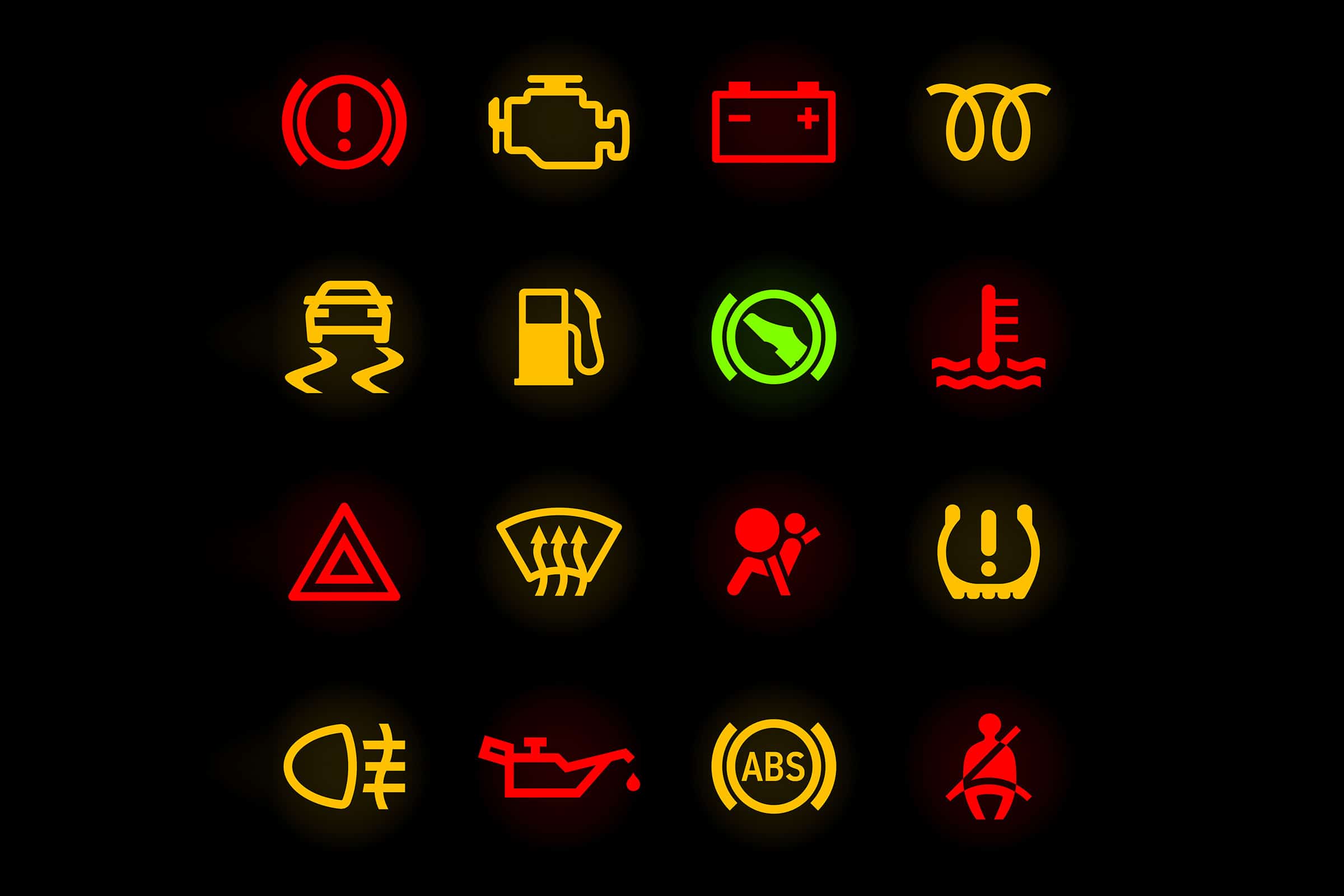
There are tons of common dashboard lights – some of them are serious, and some of them mean your car is working like it should when they turn on. So, what ones do you need to rush your car to the mechanic over, and which ones can you take care of yourself? Just keep reading our guide to find out!
Check Engine Light
It’s the most common light around. You see it on commercials, and it’s the one you probably dread seeing the most. That dread is a little overblown. Your check engine light can mean a wide variety of things, and you can get most of them repaired without breaking the bank. However, some of them are extremely serious and will lead to awfully expensive repairs if you don’t get it fixed promptly.
Why it Could Be On
Your check engine light turns on when one of a multitude of sensors gets a reading that is out of typical specifications. Your check engine light could be on for something as small as your gas cap being left open or something as serious as bad ignition coils or spark plugs.
Five Most Common Reasons for a Check Engine Light
While these are the most common reasons your check engine light might be on, you need to keep in mind that there are hundreds of potential codes. The only sure way to find out what code made your check engine light turn on is to connect it to an OBDII reader. AutoZone and just about every other parts store will do this for you for free.
#1 Faulty Oxygen Sensors
It’s by far the most common cause of a check engine light. Oxygen sensors wear out, and you need to replace them every 50,000 miles. The good news is that they aren’t expensive to replace, and if you’re even a little technically inclined, they’re usually pretty easy to replace yourself.
#2 Faulty Sparkplugs/Glowplugs
If you drive a gasoline car, you have sparkplugs. If it’s a diesel, you have glowplugs. They don’t do the same thing, but you need to replace both regularly. While this is a typical, routine, and relatively inexpensive job, you can cause extensive damage to your vehicle if you fail to replace your plugs promptly.
#3 Loose Gas Cap
It’s far more common than you think. People leave the gas station, see the check engine light, and take it straight to the mechanic. Typically, the sensor itself isn’t bad; you just need to ensure that your gas cap is fully closed.
#4 Mass Air Flow (MAF) Sensor
MAF sensors let your engine know how much air is getting pushed into the engine. While sucking in all that air, sometimes little particulates sneak past the filter and clog the MAF sensor. Without your engine knowing how much air the intake is bringing in, your vehicle can’t make critical decisions like optimizing fuel flow and engine timing.
#5 Replace Thermostat
If you have a broken thermostat, you’re going to find out sooner rather than later. That’s because your thermostat controls when to release the coolant throughout the engine. If you have a busted thermostat, your vehicle will overheat, leaving you stranded on the side of the road somewhere.
What to Do

If the only thing you notice is the check engine light – meaning that your car isn’t making any weird noises and everything feels like it’s working correctly – take it to your local parts shop to get the code read for free.
If you’re worried if your car can make it there, have someone read the code for you without moving the vehicle. If you don’t know anyone with an OBDII reader, Wal-Mart and Amazon sell them for as little as $10. Typically, you do not need to do this. Unless your vehicle displays apparent signs of a significant problem, you can drive your car to the mechanic or auto parts store even with a check engine light on.
What to do after you read the code depends on your level of mechanical expertise. You can either try to repair the code yourself or take it to a mechanic so they can fix it for you.
Still, you should always have the code read before you take it to the mechanic. This gives you an extra layer of protection since you have an idea of what the problem might be before you get there. That way, if the mechanic tries to tell you that you need different repairs or had a different problem, you know better than to fall for it.
ABS Light
Your ABS light normally looks just like it sounds – a light that says ABS. Not every car has an ABS light, because not every vehicle has antilock brakes.
However, it’s a nice safety feature that can keep you out of an accident, and if your ABS light is on, then your anti-lock brakes aren’t functioning – when the light is on, the system is automatically disabled.
Why it Could Be On
The most common reason for an ABS light is a broken wheel speed sensor. It’s the primary way your ABS operates, and like all sensors, they tend to wear out after a while. Another common reason your ABS light comes on is that your brake fluid is low, although this is a sign of a more severe condition.
What to Do
Your cheap code reader from Wal-Mart may or may not be able to read your ABS code. However, if you take your car to your local parts store, they will read it for you for free. If you need to replace a sensor or a module, you might want to take it to a mechanic unless you have experience doing it yourself.
If your ABS light is on because you have low brake fluid, you need to immediately take it to a mechanic. Your brake system is a sealed system – meaning that you shouldn’t be losing brake fluid. While you might not think a small leak is serious, small leaks can lead to big ones instantly. And if that happens, you won’t be able to stop your vehicle anymore.
Park Brake Light
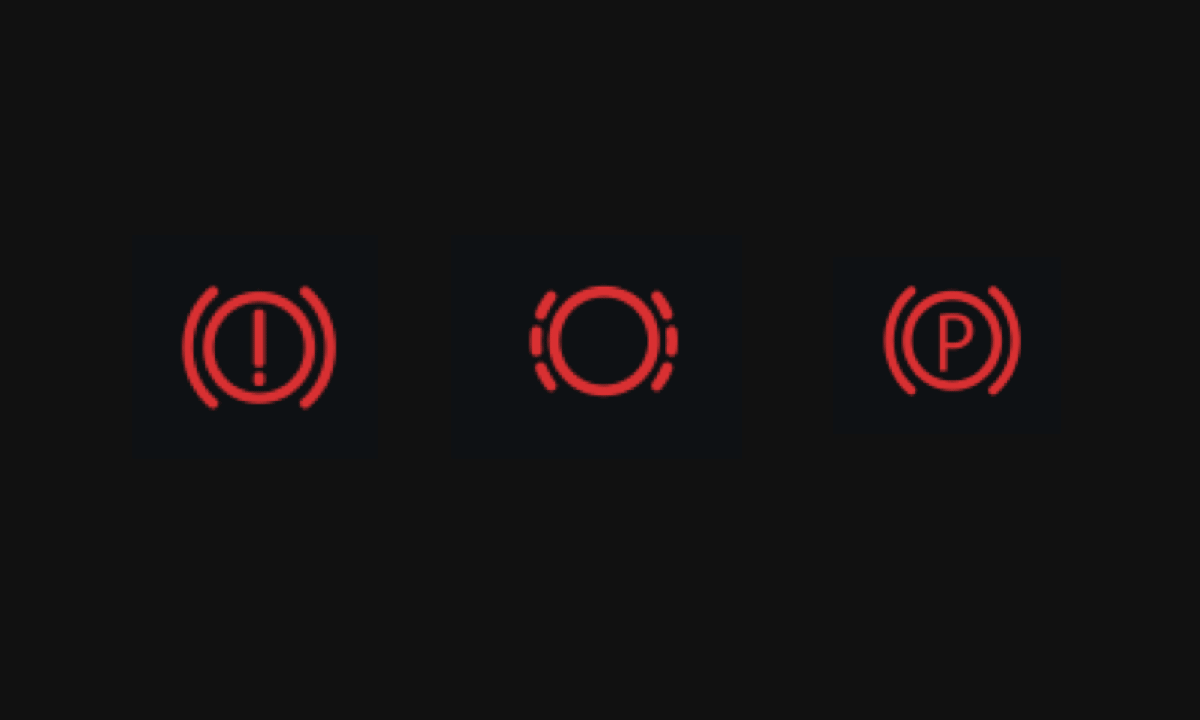
Your park brake light is typically a circle with two lines on the outside, one on each side. On the inside of the circle, there will either be a vertical straight line or a “P.”
Driving your car with the park brake light on is not advisable and could lead to your car catching fire.
Why it Could Be On
There are two main reasons your park brake light is on – either your park brake is engaged, or your sensor is faulty.
However, just because you’ve released your park brake from inside the car doesn’t mean that your park brake is actually disengaged. Your park brake has adjustments, and if it’s adjusted incorrectly, even when you disengage it from inside the vehicle, your park brake will still be held in place.
What to Do
If your park brake light is on you, you need to get it repaired. However, you don’t want to drive the vehicle with the light on unless you’re 100 percent sure that the parking brake is disengaged. If your park brake is rubbing against the rotors as you drive, they will heat up excessively. This can lead to them catching fire if you drive far enough like that.
Air Bag Light
There are two standard airbag lights. The first is someone sitting in a seat with a big circle in front of them. The second is a light that reads “AIR BAG” or “SRS.”
Your vehicle’s airbags are one of its most important safety features. If your airbag light is on, then they won’t deploy when you need them. Driving a vehicle with an active airbag light is the same thing as driving a vehicle with no airbags.
Why it Could Be On
The most common reasons for an airbag light are that something interferes with the vehicle’s seat belt sensors or a faulty clock spring. Occasionally an airbag light will come on because of a defective airbag module. However, this is rare.
What to Do
Before you take your car to a parts store to get the code read or a mechanic to get it repaired, check inside your seatbelt buckles for possible obstructions. Even if your seatbelt is clicking into place, if there is a small object like a coin in there, the sensor won’t be able to read it correctly.
If that doesn’t fix the problem, you should take your vehicle to a mechanic for repairs. Trying to work on an airbag system yourself can be extremely dangerous if you don’t know what you’re doing.
Seat Belt Light
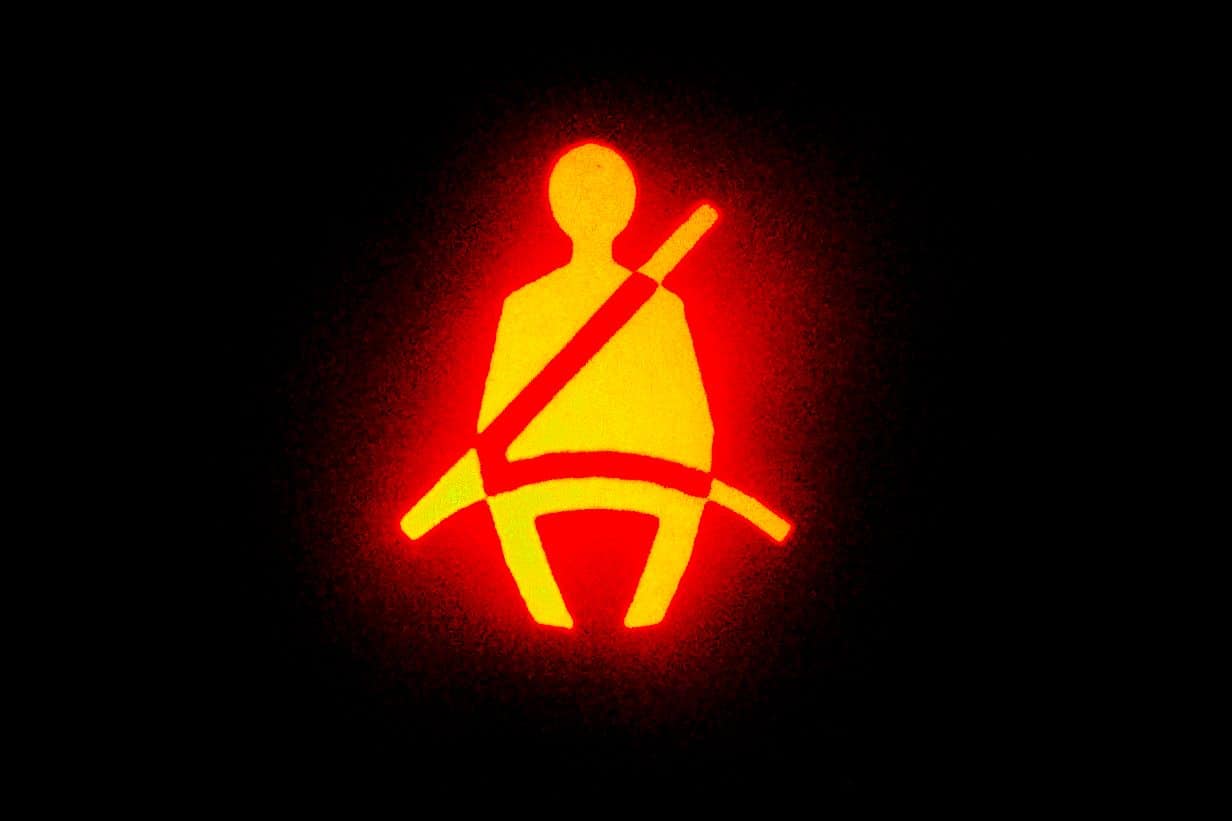
Not every car has seat belt lights, but those that do typically have a light of a person facing towards you wearing a seatbelt.
When your vehicle has this light illuminated – it’s more annoying than anything. Everything in your car will still be working properly unless your seatbelt isn’t clicking when you put it on. If that’s the case, your seatbelt isn’t working, and you’ll need to get it repaired or replaced.
Why it Could Be On
You could have something heavy on one of your seats with a built-in sensor, a passenger that isn’t wearing their seatbelt, or a faulty seatbelt sensor. None of these are expensive to repair.
What to Do
As long as your seatbelts are working correctly, you have two options to take care of this light. First, you can replace the sensor. Or you can pull the fuse for the seat belt light. Your car won’t be able to tell if you if everyone is wearing their seatbelt, but you won’t have to deal with it dinging at you for your entire trip, and you won’t need to spend any money on repairs.
TPMS Light
Your TPMS light is two half circles connected with a squiggly line along the bottom with two straight vertical lines at the top. In the middle is a “!”. It’s supposed to be a tire against the pavement, but it takes a bit of imagination to see it.
The TPMS light is another optional light – although almost all newer cars have them. It alerts you of low air pressure in your tires, and it’s usually pretty easy to fix.
Why it Could Be On
By far, the most common reason for a TPMS light is the low air pressure in one or more of your tires.
Your tire pressure will change with the temperature, and if you never put more air in your tires, your tires will be underinflated. Your TPMS sensor is there to let you know when you need to fill them back up!
However, if your tire pressure is correct and your TPMS light is still on, you likely have a faulty TPMS sensor. Each wheel has one, and occasionally one of them will stop working properly.
What to Do
The first thing you need to do is check the air pressure in all of your tires and compare it to what the air pressure should be. You can usually find this if you open your driver’s door and look against the frame. If the sticker is missing, check your owner’s manual.
If all the tire pressures are correct, then you probably have a faulty TPMS sensor. These sensors are attached to the inside of your rim at the valve stem, so you’ll need to get your tire removed to replace it. Your TPMS sensor is not a safety feature, so if you want to put off getting it replaced, you can.
However, you’ll need to keep an eye on your tire pressure because you won’t have a sensor to rely on to help you!
Battery Light
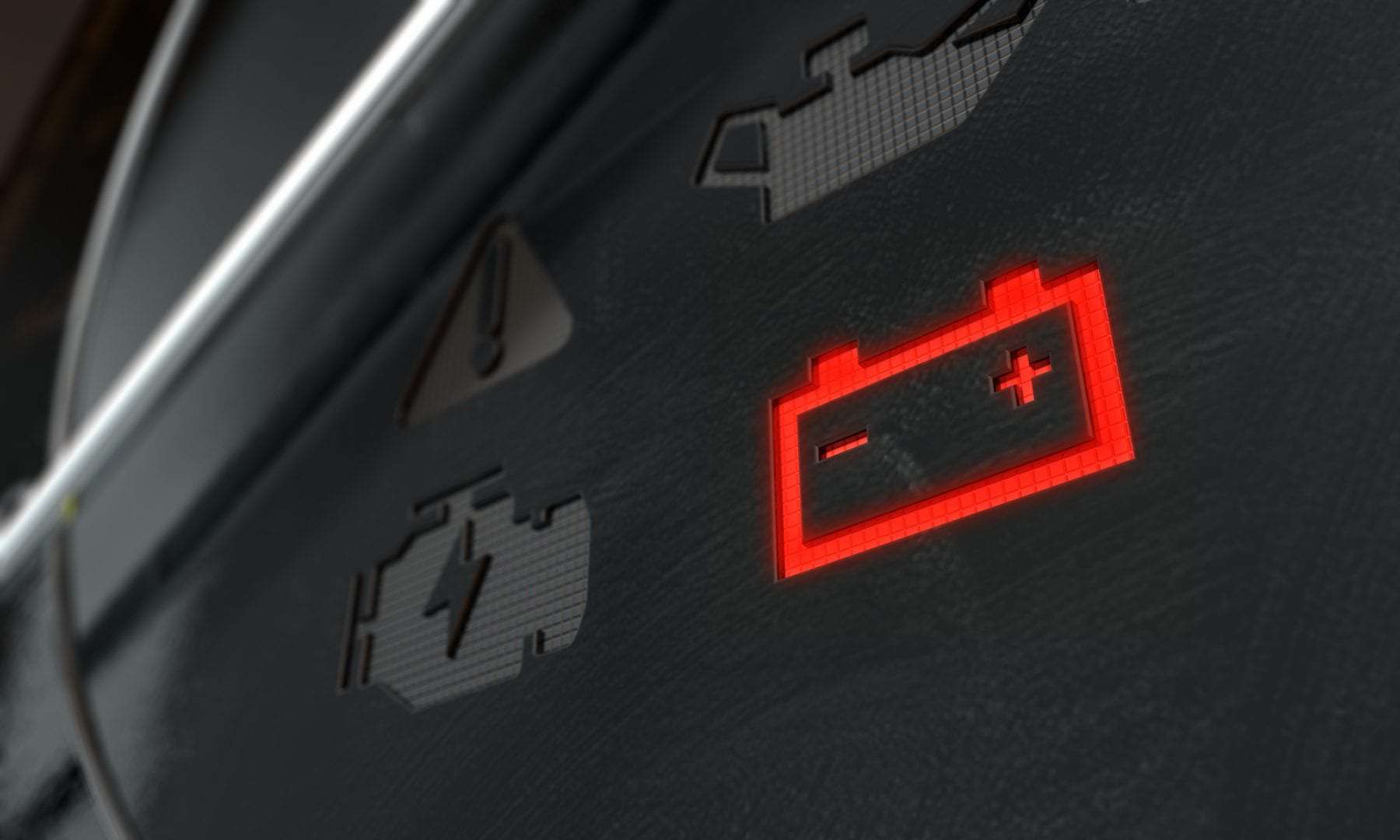
The light itself is a rectangular box with two knobs on the top and a “-” and “+” illuminated inside it. If your car is off, this light is almost always on. However, if this light turns on while driving, your charging system isn’t working properly, and you need to get it to a repair shop.
Why it Could Be On
There are three main reasons your battery light could be on. The most common reason is that your car isn’t running! Your battery light is an indication of your charging system. Your charging system includes your alternator, which is driven by your engine belt, which doesn’t spin when your engine is off.
The other two options indicate a problem. First, your alternator could be bad, which means your battery isn’t getting charged as you drive. Second, your battery might be bad and unable to hold a charge. It doesn’t matter how much juice your alternator is sending if your battery can’t hold it!
What to Do
If your battery light comes on while driving, you need to take it for repairs. If you run out of power while driving, your engine will shut off while you’re driving. This will leave you stranded somewhere, dependent on a jump start to get going again.
Even worse, a jump start won’t fix your problem, so you’ll end up breaking down on the side of the road again before too long!
Glowplug Light
Your glow plug light is a squiggly line that makes two loops. If you drive a diesel, you’ve seen this light, and if you haven’t seen it, that’s a problem. If you drive a gasoline-powered vehicle, you don’t have glowplugs, so you don’t have a glow plug light.
Why it Could Be On
Your glowplugs warm up your diesel engines combustion chamber before you start the engine. Every time you drive a diesel, you should turn the key to the on position and wait for the glowplug light to turn off.
This lets you know when the glowplugs have done their job and warmed the combustion chamber to an acceptable temperature. During colder days, this will take longer, and during the hottest summer days, it might only turn on for the system check.
Of course, if your glowplug light doesn’t turn off, then it’s a sign that you need to replace them. The glowplug light reads when the engine gets the right temperature, and if your glowplugs aren’t doing their job, then the engine will never reach that temperature.
What to Do
The first thing you need to do is wait to start the engine when the light turns on. If it turns off after waiting a bit, you don’t need to do anything, and your glowplug light is working properly. However, if it stays illuminated, then you likely need to change your glow plugs.
Low Oil Light

It’s one of the most serious lights you can have on. It typically looks like an oil can with a drop of oil coming out. While it’s commonly referred to as a low oil light, it’s really indicating low oil pressure.
Oil is an integral part of your engine. It keeps everything cool, clean, and lubricated. If you’re running your engine without oil pressure, you lose all of those benefits. If you’re driving your engine with a low oil light, it’s not a matter of if you’ll total your engine, it’s a matter of when.
Why it Could Be On
The most common reason is right in the name – low oil light comes on when you have low oil. If you didn’t just complete an oil change, this means that you either have a pretty serious leak, or your engine is burning oil.
You could also be using the wrong oil in your car, or your engine might need significant repairs.
What to Do
The first thing you should do is check the dipstick in your vehicle. If you don’t see any oil on it, then you’ve identified the problem. Top off your oil, then try to determine where the leak is coming from.
If you’re unable to complete the repairs, yourself take it to a shop for maintenance. However, if you can identify where the leak is coming from before taking it to the shop, you’ll be less likely to get ripped off.
Engine Temperature Light
It’s one of the weirder looking lights. It has two squiggly lines along the bottom, with what looks like an old-school thermometer coming out of them.
This light will come on when your engine is significantly overheated. You need to get your car to a safe place immediately and turn it off. If you wait, your vehicle will likely shut off by itself before too much damage can be done.
Why it Could Be On

There are a few different components that could lead to your engine overheating. The four most common are faulty water pumps, faulty thermostats, a defective fan, or low coolant.
Faulty water pump
Your water pump is what pushes your coolant throughout the engine. While it’s rare that they break, it can happen, and if it does, your engine will overheat quickly.
Faulty thermostat
It’s the most likely explanation for an overheating engine. It’s a remarkably simple design that opens up when the engine reaches a specific temperature. This allows the coolant to flow throughout the engine and keep everything cool. However, if the thermostat gets stuck closed, then your engine will overheat, and you’ll need to replace the thermostat.
Faulty fan
Tons of electrical components go into telling your fan to turn on and off at the appropriate time. At the same time, it’s rare for the fan itself to go bad; the electrical components that make it function break from time to time. Without the additional airflow that your fan provides, your engine can quickly overheat.
Low coolant
All your components can be working just like they are supposed to, but if you don’t have any coolant in your system, it won’t do any good. Your cooling system is a sealed system, so if you are low on coolant, that means it’s going somewhere it shouldn’t. Either your vehicle has a leak, or your engine is burning coolant.
What to Do
After you identify the faulty component, you’ll need to get it fixed. If you can get your vehicle to a repair shop without it overheating, you can drive it there. However, if it is overheating too quickly, you might need to get it towed.
If you are low on coolant, top it off before making any trips to a repair shop.
Press Brake Pedal Warning Light
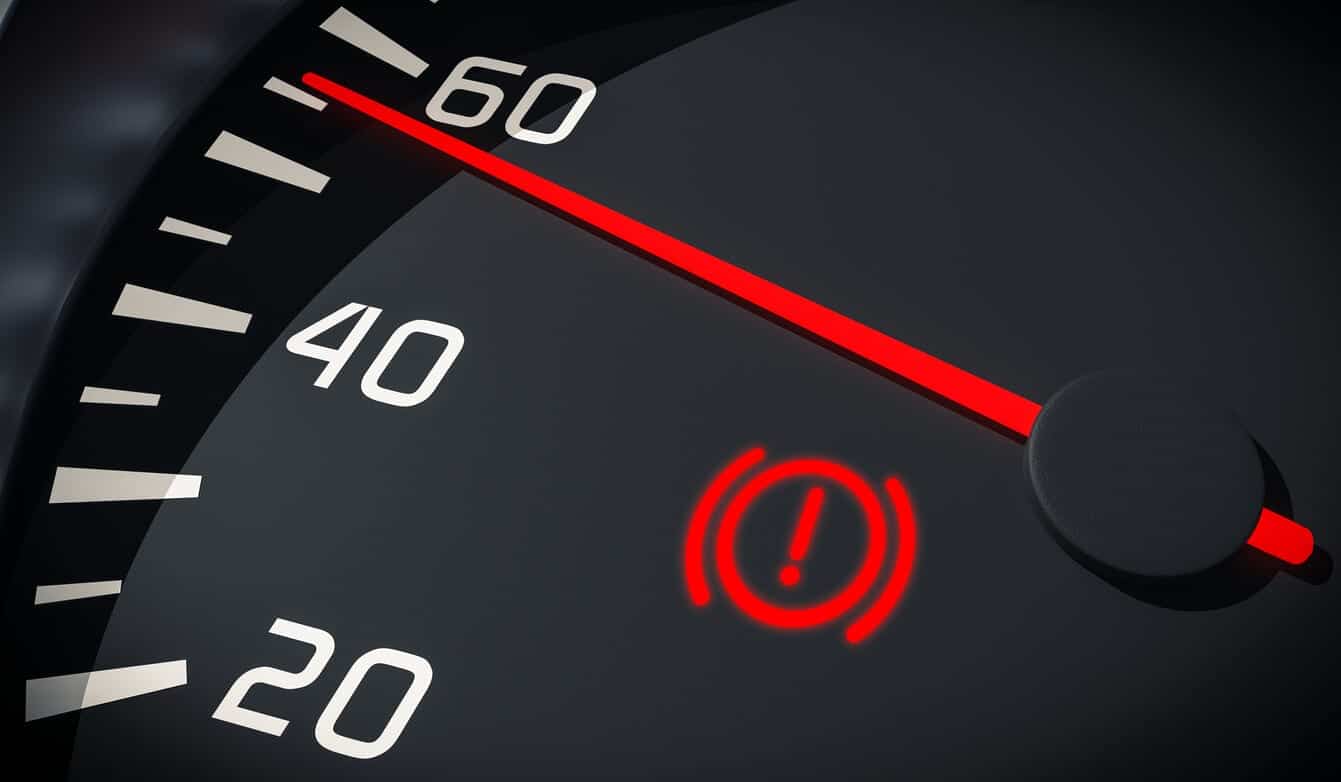
Your brake pedal warning light, or clutch warning light, simply tells you that you need to depress the brake or clutch before you can shift your car if you are driving a manual. Having this light illuminated isn’t a problem unless it doesn’t go out when you press the brake or clutch.
Why it Could Be On
When your car is in the park, the light is usually illuminated. Once you put your foot on the brake and shift out of the park, the light should stay off.
However, if the light stays on when you depress the brake, you have a lousy brake pedal sensor. You won’t be able to shift out of the park before you replace the sensor.
What to Do
Replace the sensor! It’s not hard to get to, and unless you are completely mechanically challenged, you can do it yourself. If not, you’ll have to get someone to your car or get it towed for repairs.
Power Steering Light
Your power steering light will look like a steering wheel and sometimes have a “!” next. This light means that your power steering fluid is low. Your power steering fluid makes it easier to turn, and if you lose your power steering completely as you drive down the road. If you’re not extremely strong, you might not be able to control your car anymore.
Why it Could Be On
Your power steering light comes on when your power steering fluid gets low. It’s a sealed system, so if your power steering fluid is low, it’s because your vehicle has a leak somewhere.
What to Do
You need to locate the leak and get it repaired. Sometimes it’s as simple as a hose clamp is loose. Other times the entire line or pump is busted. Either way, you’ll need to get it repaired, or else you won’t be able to effectively control your car as you drive.
Low Fuel Light
If there’s any light that you’ve likely seen on, it’s this one. It looks like a gas pump with a hose coming out of the side of it.
Why it Could Be On
Obviously, it could be on because you need more fuel. But what if it’s still on after you just filled up? There’s a sensor in your gas tank that controls your low fuel light. That sensor is called a float gauge, and it controls both your low fuel light and your fuel gauge.
What to Do
If you have a lousy float gauge that keeps your low fuel light on, you can do one of two things. You can ignore it and keep track of how much fuel is in your tank by how many miles you’ve driven, or you can drop your fuel tank and replace the gauge. However, this is a labor-intensive task and might cost a little more than you want to spend if you take it to a mechanic shop.
Oil Change Light

At the service interval, your vehicle might let you know that it needs an oil change. This light is an oil can with a drop coming out with a wrench next to it. Sometimes your car will have a message pop up saying that it needs an oil change. It’s important to note that the manufacturer presets this, so if you use synthetic oil, you might not need an oil change every time it turns on.
Why it Could Be On
Once you’ve reached a certain number of miles, your change oil light will automatically come on. Some cars will let you set the interval between oil change reminders, and others do it automatically. Either way, the only reason this light should be coming on is that you need an oil change.
What to Do
If you need an oil change, you should get one. However, that won’t reset your change oil light all by itself. Your vehicle’s manufacturer decides the procedures on how to reset your oil change light. Sometimes you can reset it through your vehicle’s dashboard or radio.
But for some vehicles, you’ll need to turn the key on, press the brakes a few times, and a few other steps to reset it. The easiest way to find out how to reset your vehicle’s change oil light is to Google how to reset it for your specific manufacturer.
Summary
It might be a little overwhelming when you see all those lights flashing on your dashboard, and you don’t know what they mean. But if you take them one light at a time, you can rest assured that when one does come on, you’ll know exactly what to do. Even better, you can avoid getting ripped off at the shop or dealership!








